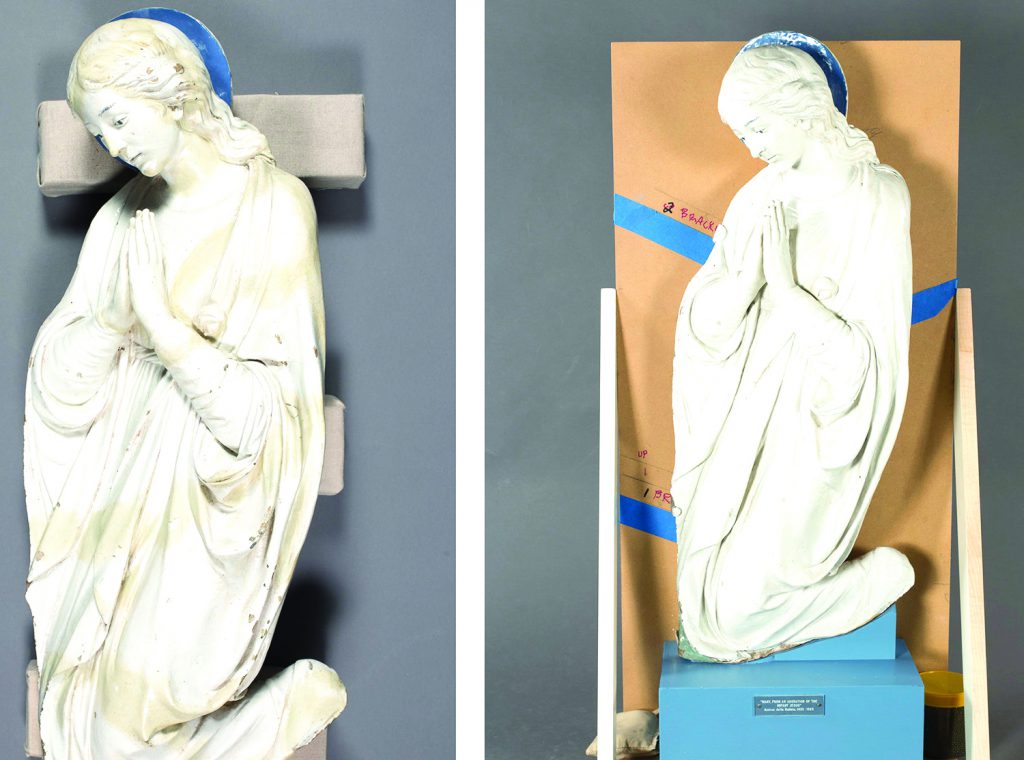
Courtesy The Hyde
Artists’ secrets uncovered in recent conservation projects are on display in “Masterpieces Under the Microscope: Andrea della Robbia and James Brade Sword,” an exhibition running through Sept. 15 at The Hyde Collection in Glens Falls.
The exhibition presents for the first time since their conservation two works from the museum’s collection: a terracotta sculpture, Madonna, circa 1480, by Andrea della Robbia, and a landscape painting, “A Peep Into Lake George” (1873) by Hudson River School artist James Brade Sword.
The projects were completed at Williamstown + Atlanta Art Conservation Center and funded by a grant from Greater Hudson Heritage Network, a partner of state Council on the Arts.
Museum founder Charlotte Hyde purchased Madonna from Brummer Gallery in New York in 1936, and had the statue installed at the foot of the stairs in Hyde House. The high-relief representation of the Virgin Mary was likely originally part of a large-scale, multi-piece depiction of “Adoration of the Christ Child.” Now missing is at least a figure of the Christ Child lying in a bed of straw.
Larger such tableaux would also include an ox, an ass and attendant angels. The history of Madonna and the relief, and how this figure became separated from the rest of the relief, is unknown.
Conservators examined damaged areas on the figure’s neck, hands, halo, nose, and cheek. It was believed the discolored bands were earlier patches, masking minor stress cracks that occurred during firing. Experts expected to be able to remove the yellowed overpaint and spackle and make repairs relatively easily. However, they discovered more extensive damage than anticipated, and forms of restoration they had never seen before, museum officials said.
Damage extended over 30 percent of the sculpture. Officials said to restore it, an earlier conservator had not filled losses with spackle, as a modern conservator would, but had molded and fired ceramic fills, in much the same way as Andrea della Robbia had made the original in the fifteenth century.
By analyzing the composition of the glaze using X-ray florescence (XRF) spectroscopy, conservators were able to determine an approximate date of the restoration. They took samples from both original areas — the Virgin’s cheek and robe — and from fills in her hands and the tail of her robe, then bombarded them with radiation. The conservators were able to determine the composition of each sample, noting that each contained a high degree of lead and some tin, both common elements in traditional formulae for white glaze. Only the repairs contained zinc, which wasn’t identified as a distinct element until 1746, suggesting the sculpture was repaired several centuries after its creation.
“I had heard that there was a period when restorers repaired damaged della Robbias using the same techniques to mold and cast the terracotta as the family had used in its workshops,” said Williamstown + Atlanta Conservation Center objects conservator Helene Gillette-Woodard. “But I had never seen it in person. The old ways persisted for much longer than we think. The ceramicists really had to know their craft to mold a piece to the right size and shape so that once it had been fired—when it would invariably shrink —it could still neatly fit into place.”
Also included in Masterpieces Under the Microscope is one of the Museum’s two Baskets of Fruit. (A second is exhibited in the Music Room of Hyde House; Luca della Robbia’s Madonna of the Lilies is exhibited in the home’s stairwell.)
The work was created under Giovanni, son of Andrea and great-nephew of Luca, under whose reign the family style adopted a broader range of colors, evident in the realistic depiction of ripening fruit and creatures it attracts.
James Brade Sword’s “A Peep into Lake George” is an example of Hudson River School painting. The movement is considered to be the first distinctly American school of landscape painting.
Sword (1839–1915) was trained as an artist at the Pennsylvania Academy of the Fine Arts.
